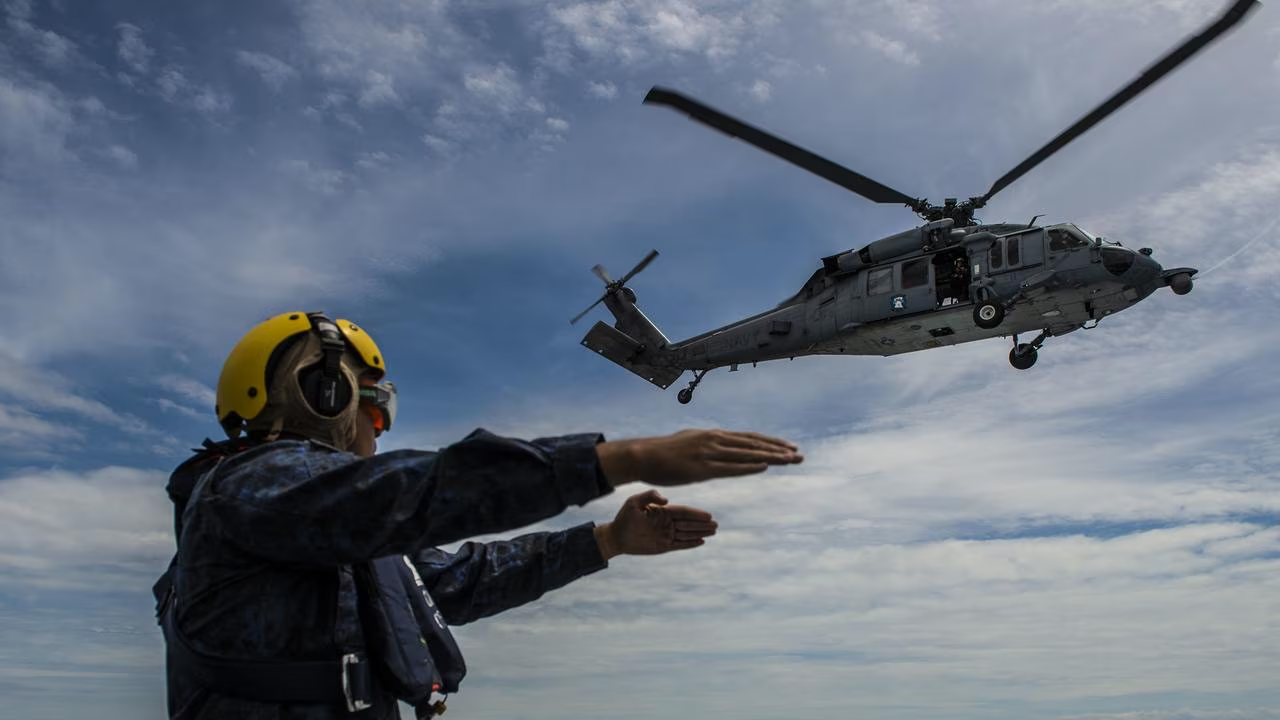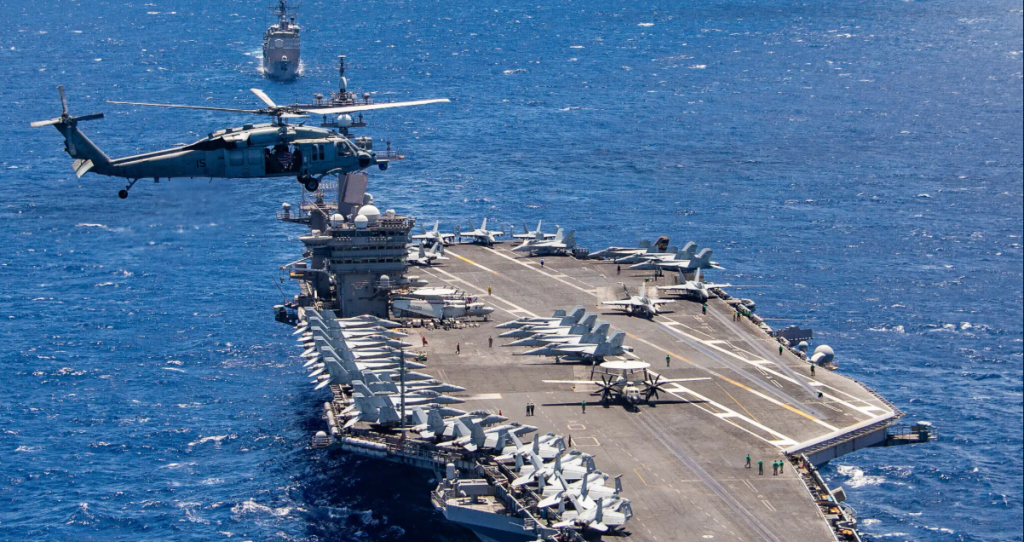World News
Two US Military Aircraft Crash in the South China Sea All Crew Members Miraculously Survive
A U.S. Navy helicopter and a fighter jet operating from the legendary aircraft carrier USS Nimitz crashed in separate incidents in the South China Sea, but all personnel survived as the Navy launches investigations into both accidents.

In a tense and dramatic day over the South China Sea, two separate U.S. Navy aircraft — a MH-60R Seahawk helicopter and an F/A-18F Super Hornet fighter jet — crashed during what officials described as “routine operations” from the aircraft carrier USS Nimitz. Despite the double disaster, every crew member was rescued alive, according to the U.S. Pacific Fleet.
The First Incident: MH-60R Seahawk Goes Down
At approximately 2:45 p.m. local time on October 26, the Navy’s MH-60R Seahawk helicopter — part of the “Battle Cats” unit from Helicopter Maritime Strike Squadron (HSM) 73 — went down while performing standard operations.
The MH-60R Seahawk is a multi-mission aircraft designed for anti-submarine and surface warfare. Known for its versatility and resilience, it is often deployed from U.S. aircraft carriers for patrol, reconnaissance, and rescue missions.
Thanks to swift search-and-rescue (SAR) operations, all three crew members aboard were found and rescued in time. According to a statement released by the Navy, “All personnel involved are safe and in stable condition.”
ALSO READ : Rockets Guard Fred VanVleet Tears ACL and Likely to Miss 2025-26 Season
The Second Incident: F/A-18F Super Hornet Crashes Hours Later
In a startling follow-up event, an F/A-18F Super Hornet from Strike Fighter Squadron (VFA) 22, nicknamed the “Fighting Redcocks,” also crashed into the South China Sea. The incident occurred while conducting similar operations from the USS Nimitz, raising immediate questions about whether the two accidents were linked or coincidental.
The F/A-18F Super Hornet, a twin-engine, carrier-capable multirole fighter designed by Boeing, has been a cornerstone of U.S. naval aviation for decades. Fortunately, both pilots successfully ejected before impact and were promptly recovered by nearby naval units.
The USS Nimitz — A Floating Fortress
The USS Nimitz, commissioned in 1975, is the oldest active aircraft carrier in the U.S. fleet and one of the largest warships in the world. The ship — named after Fleet Admiral Chester W. Nimitz — has a storied history spanning nearly five decades. It is scheduled to be decommissioned in 2026, marking the end of an era for the U.S. Navy’s nuclear-powered supercarriers.
The Nimitz often operates as part of the Carrier Strike Group 11, which includes destroyers, cruisers, and logistics vessels. The carrier’s current deployment in the South China Sea, a region fraught with territorial disputes involving China, the Philippines, and Vietnam, underscores its strategic importance to maintaining freedom of navigation and deterrence in the Indo-Pacific.

Ongoing Investigation and Global Attention
The U.S. Navy confirmed that both incidents are now under investigation. A spokesperson from the U.S. Pacific Fleet emphasized that “no hostile activity” was involved and that the crashes appeared to be accidental operational failures.
Military analysts suggest that while such accidents are rare, they underscore the high-risk environment of naval aviation, where complex machinery, rough weather, and rapid operations can combine to create dangerous conditions.
Defense expert Mick Ryan, a retired Australian Army Major General, commented on X (formerly Twitter), noting that “even the most advanced militaries in the world face the unpredictable dangers of sea-based aviation.”
Strategic Implications in the South China Sea
The twin crashes come at a sensitive time in the South China Sea, where tensions between the United States and China remain high. Beijing frequently protests U.S. naval movements in the region, claiming sovereignty over most of the sea through its controversial nine-dash line.
The Pentagon has repeatedly affirmed that U.S. military operations in the area are lawful under international maritime law, asserting that “freedom of navigation” is essential to global stability.
While there is no evidence linking the crashes to regional tensions, their timing may still draw scrutiny from Chinese state media, which often frames such incidents as signs of “reckless Western interference.”
A Reminder of the Human Cost of Routine Missions
Although no lives were lost, the double accident serves as a reminder of the daily risks faced by men and women serving aboard America’s front-line carriers. The crews of the USS Nimitz continue to operate in one of the most contested maritime zones on the planet — balancing power projection, regional diplomacy, and constant readiness.
As investigations continue, U.S. defense officials have praised the rapid response of rescue teams and the professionalism of naval personnel involved. “Their training and courage ensured everyone came home safely,” the Navy’s statement read.
For now, the USS Nimitz remains on active duty, its deck once again cleared for takeoff — a testament to the resilience of U.S. naval aviation and the enduring spirit of those who serve at sea.
World News
Strong Winds Topple Statue of Liberty Replica in Brazil, Massive Structure Collapses in Guaíba
Nearly 40-metre-tall replica outside a Havan store crashes during violent storm; no injuries reported

A towering replica of the Statue of Liberty collapsed in southern Brazil after powerful winds battered the city of Guaíba on Monday afternoon, triggering widespread damage across the region. Local authorities confirmed that no injuries were reported in the incident, which unfolded at the peak of a severe storm system.
The nearly 40-metre-tall structure was installed in the car park of a Havan retail megastore, close to a fast-food outlet, when intense wind gusts struck the area. Dramatic footage shared online shows the replica tilting under the pressure of the wind before crashing to the ground and breaking apart. The statue’s head was crushed on impact.

What collapsed and what remained intact
According to company officials and local reports, only the upper portion of the statue, measuring approximately 24 metres (78 feet), collapsed. The 11-metre-high pedestal remained standing and did not suffer structural damage. The replica was one of several similar installations placed outside Havan stores across Brazil as part of the retailer’s branding.
Havan confirms certification and swift response
In an official statement, Havan said the statue had been installed when the store opened in 2020 and possessed all required technical and safety certifications. The company confirmed that the surrounding area was immediately cordoned off following the collapse, and specialist teams were deployed to remove debris within hours.
Store operations continued in unaffected sections of the property, though access to the area around the fallen structure remains restricted pending further inspections.
Mayor and civil defence react
Guaíba mayor Marcelo Maranata confirmed that there were no casualties and praised the rapid response by emergency teams. He said municipal workers coordinated closely with state Civil Defence officials to secure the perimeter and assess potential risks to nearby structures.
The incident occurred at around 3 pm, when the storm was at its most intense.
Extreme weather behind the collapse
Meteorological authorities reported wind gusts exceeding 90 kmph, with some areas recording speeds close to 100 kmph. The National Institute of Meteorology attributed the sudden and violent winds to a passing cold front, which triggered severe weather across much of Rio Grande do Sul.
The storm caused widespread disruption in the region, including fallen trees, damaged roofs, hailstorms, temporary power outages, and localized flooding in several neighbourhoods. Emergency weather alerts had earlier been sent directly to residents’ mobile phones, warning of strong winds and heavy rainfall.
Technical inspection ordered
Havan confirmed that a technical inspection will be conducted to determine whether factors beyond extreme weather may have contributed to the collapse. Authorities will also assess other similar structures to ensure safety standards are met.
Weather officials said conditions are expected to gradually improve from Tuesday, though intermittent rain may persist in parts of southern Brazil.
World News
This Film Will Make You Uncomfortable And That’s Exactly Why America Needs to See Torn
A documentary about torn-down hostage posters becomes a chilling mirror of grief, identity, and how the Israel–Hamas war fractured everyday life in New York City

There are films that reassure you. Then there are films that refuse to. Torn belongs firmly in the second category — and that’s precisely why it matters.
“If you want a film that confirms your beliefs, Torn isn’t it,” says executive producer Jane Rosenthal, and she’s right. This documentary does not hand out comfort. It asks uncomfortable questions and then sits quietly while the audience wrestles with them.
Days after the October 7 Hamas attacks on Israel, as war erupted in Gaza and a humanitarian crisis unfolded, something seemingly simple appeared across New York City. Posters. Faces. Names. Stories.
At the top, printed in red, a single word: KIDNAPPED.
The posters showed the faces of 251 people abducted by Hamas — children, grandparents, Hindus, Buddhists, Christians, Muslims, and Jews. A deliberate reminder that terror did not discriminate.
And then, just as suddenly, the posters began to disappear.
ALSO READ : Younghoe Koo Explains Botched Field Goal After Slip: “The Ball Was Moving So I Pulled Up”
Videos flooded TikTok and Instagram. People were filmed tearing the posters down, while others filmed themselves putting them back up. Heated street arguments followed. Students were doxxed, employees were fired, politicians weighed in, and friendships collapsed — all over pieces of paper stapled to lampposts.
But Torn makes one thing painfully clear: this was never really about posters.
It was about identity.
It was about grief.
It was about who gets to be seen — and who doesn’t.
As Jane Rosenthal — co-founder of Tribeca Enterprises and longtime producing partner of Robert De Niro — explains, Torn is not a film about the Middle East. It’s a film about America. About how the emotional aftershocks of a distant war cracked open daily life in one of the most diverse cities on Earth.
New York, a city that prides itself on coexistence, suddenly couldn’t agree on whose pain mattered.
Art became protest.
Protest became confrontation.
And a lamppost became too politically charged to touch.

What began as a grassroots awareness campaign quickly turned into a symbolic battlefield. Some people ripped the posters down in anger. Others taped them back up with shaking hands. Most simply walked past — not out of cruelty, but confusion. They no longer knew how to respond to grief that wasn’t their own.
That may be Torn’s most unsettling truth.
We have lost the ability to sit with someone else’s pain.
The film captures how reactions themselves became performances — curated for social media, filtered for ideology, amplified for likes. Grief turned into content. Outrage became identity. Silence became suspect.
And yet, Torn never tells the viewer what to think. It refuses to flatten the complexity of the moment. Instead, it documents how quickly empathy collapses when politics enters the room — and how fragile coexistence truly is when people stop seeing each other as human first.
In a media landscape overflowing with hot takes and moral certainty, Torn dares to do something radical: it asks the audience to feel uncomfortable — and stay there.
Because discomfort, the film suggests, is not the enemy. Indifference is.
This is not a documentary that will leave everyone satisfied. Some will be angry. Some defensive. Some deeply unsettled. But very few will walk away unchanged.
And that may be its greatest achievement.
World News
“Trump hints America may ‘never pay income tax again’… but experts warn the math tells a very different story”
As President Donald Trump floats a dramatic plan to replace federal income taxes with tariff revenue, economists say the idea could reshape — and even destabilize — the U.S. financial system.

For millions of Americans struggling with rising bills, the idea sounded almost too good to be true. At a recent Cabinet meeting, President Donald Trump suggested that the country might soon reach a point where citizens “won’t even have income tax to pay”, claiming booming tariff collections could eventually replace the federal individual income tax system altogether.
The comment instantly sparked national debate — not just because of its boldness, but because it challenges one of the core pillars of the U.S. fiscal framework.
But tax experts, economists, and policy analysts tell a very different story.
Tariffs vs. Income Tax: Why Experts Say the Numbers Don’t Add Up
According to Erica York, a leading tax policy expert at the Tax Foundation , the proposal is “mechanically impossible.”
York estimates that even if the current tariff structure under the Trump administration were kept in place for the next decade, it would generate only about $2.1 trillion. In contrast, federal individual income taxes are projected to bring in more than $32 trillion over the same period.
“The U.S. simply doesn’t import enough goods to generate that kind of money,” she noted. “Replacing income tax with tariffs would not just be unrealistic — it would be economically harmful.”
Federal income taxes currently bring in $2.7 trillion annually, while tariff revenue in 2025 totaled just $195 billion, according to Treasury data.
Why Economists Say Tariffs Would Hit Working Families the Hardest
Another major concern raised by experts is who pays the real price.
Although the administration argues that foreign exporters absorb the cost, economists say the majority of tariff burdens fall on U.S. companies and consumers, who then face higher prices for everyday products — from electronics to clothing to food.
Scott Lincicome, an economist at the Cato Institute , warns that replacing income tax with tariffs would shift the burden disproportionately onto low- and middle-income households.
“Tariffs are effectively a flat consumption tax,” he explained. “Income tax is progressive. Switching systems would help high earners and hurt the working class.”
According to the Tax Foundation, the top 10% of earners currently pay 72% of all federal income taxes — meaning any switch to tariff-based funding would reduce their tax responsibility while increasing the financial load on the remaining population.

Trump’s “Tariff Dividend”: Another Expensive Promise
President Trump has also floated the idea of sending Americans a one-time $2,000 “tariff dividend” check funded by tariff revenue.
But Lincicome calls this “mathematically impossible” under current conditions.
Issuing such a check nationwide would cost between $300 billion and $600 billion, far exceeding the annual tariff revenue.
“It’s simple arithmetic,” he said. “The revenue just isn’t there.”
Congressional Reality Check
Even if the numbers worked — and experts say they don’t — the proposal faces another hurdle: Congress.
Changing the federal tax code, whether to eliminate income tax or to introduce dividend checks, requires legislative approval. And early responses from lawmakers show sharp divisions.
Sen. Ron Johnson recently dismissed the $2,000 payout idea, stating the country “can’t afford it.”
Could Tariffs Ever Generate Enough? History Says No.
A report from the Yale Budget Lab found that the current average effective tariff rate has reached 17%, the highest since 1935.
Economists warn that increasing tariffs further — to the 20–30% level needed to even approach income-tax replacement — would cause Americans to stop buying imports, collapsing tariff revenue entirely.
“There is a ceiling,” Lincicome explained. “Push tariffs too high, and revenue collapses. Push them even higher, and the economy collapses.”
A Vision or a Warning?
President Trump’s bold claim has energized supporters who see tariffs as a way to rebalance global trade and reward American workers. But experts caution that the plan could dramatically shift the economic burden toward the very households the government aims to help.
As the Supreme Court continues evaluating the constitutionality of Trump’s tariff policies, and as the 2026 fiscal debate intensifies, one thing is clear:
The idea of a tariff-funded America may be politically appealing — but economically, it is deeply complicated.
For more Update – DAILY GLOBAL DIARY
-

 US News1 week ago
US News1 week ago“She Never Made It Out…” Albany House Fire Claims Woman’s Life as Family Pleads for Help to Bring Her Home
-

 Entertainment1 week ago
Entertainment1 week agoXG Star Cocona Shares a Brave Truth at 20 — “I Was Born Female, But That Label Never Represented Who I Truly Am…”
-

 Entertainment1 week ago
Entertainment1 week agoSamba Schutte Reveals the Surprise Cameo in Pluribus That “Nobody Saw Coming”… and Why John Cena Was Perfect for the Role
-

 Entertainment6 days ago
Entertainment6 days agoSaudi Arabia’s entertainment revolution… Red Sea Film Foundation CEO Faisal Baltyuor says he ‘wears many hats’ — but one mission drives them all
-

 Entertainment1 week ago
Entertainment1 week agoMandy Moore Signs On for a Bold New Peacock Erotic Thriller — “A Twisted Game Where the Student Becomes the Teacher…”
-

 Entertainment6 days ago
Entertainment6 days ago“Nicholas Hoult breaks silence on childhood fears… ‘Everyone told me child actors disappear’ — what he revealed at Red Sea Festival
-

 Entertainment3 days ago
Entertainment3 days agoAmy Schumer and Chris Fischer Split After 7 Years of Marriage — Inside Their ‘Cohesive’ and Amicable Divorce
-

 Politics7 days ago
Politics7 days ago“If I Can’t Beat Jimmy Kimmel, I Shouldn’t Be President…” Trump Drops Bold Claim Ahead of Hosting Kennedy Center Honors




















